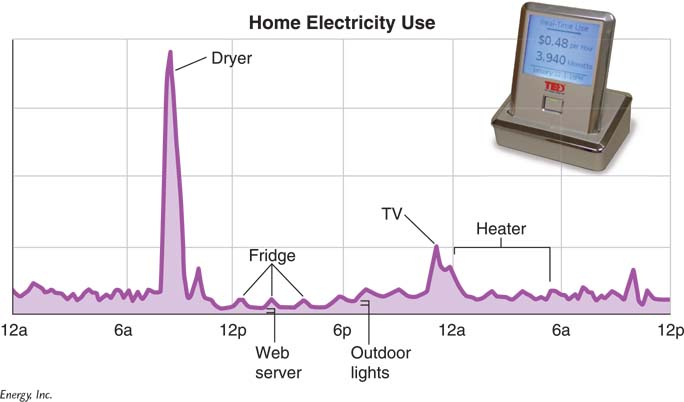working toward  sustainability
sustainability
Meet TED: The Energy Detective
It is generally accepted that peer pressure influences behavior. When hotels placed small signs in bathrooms telling their guests that other guests were reusing their towels rather than insisting on receiving fresh clean towels each day, the need for towel laundering dropped drastically. Many studies have shown that when people receive feedback about their electricity consumption, they will often respond just as the hotel guests did. A number of electric companies have experimented with mailings that show homeowners how much electricity they use in comparison with neighbors in similar-
For decades, environmentalists have dreamed about a magical device that could allow homeowners to receive an instantaneous reading of actual electricity use in the home. Today, environmental scientists have produced such devices. One example is The Energy Detective (TED), which provides a readout on a small device that can sit on the kitchen table or be viewed on a laptop computer. And there are many other similar devices and software packages available, including some that allow you to view your home electricity use on a laptop over the Internet.
TED and other such electricity monitoring devices provide an instantaneous readout of electricity use in your home. Suppose you are getting ready to head out for the evening. The refrigerator is plugged in, but is quiet, meaning that the compressor is not running at that exact moment. Before you turn out the last light and leave, you glance at TED and see that your house is drawing 500 watts. Wait a minute, that’s not right! Then you remember that you left your Xbox 360 game console and 42-

Since we know that all electricity use has environmental implications, a reduction in electricity use by any means is beneficial. The reductions that come from simple changes in behavior are some of the easiest to achieve.
Critical Thinking Questions
How does the energy meter described here compare with typical energy meters?
What are some major contributors to phantom load in a home and what prevents manufacturers from making electrical items that don’t draw a phantom load?
References
Ayres, I., S. Raseman, and A. Shih. 2009. Evidence from Two Large Field Experiments That Peer Comparison Feedback Can Reduce Residential Energy Usage. Working Paper 15386, National Bureau of Economic Research.
Schor, J. 2004. Born to Buy. Scribner.